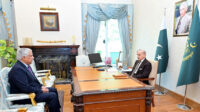As per China’s former enigmatic development adventures in Africa and central Asia, the veracity of CPEC is clouded by ambiguity. However, policymakers in Pakistan and their counterparts in Beijing have shunned the criticism by labeling them as Indian and American propaganda. They may be right, nevertheless, each corner of this so-called game-changer project leaves austere curiosity. Since previously countries like Tajikistan and Sri Lanka have been lured to China’s debt-trap. The debt-trap, which is covered with promises of development and prosperity for struggling economies of the world, ends up in a trap to cede their strategic and multi-beneficial assets to Chinese subtle hegemony. According to a report published by Washington in 2018, Pakistan is one of the six countries of the world to fall prey to China’s trap. About 15% of its external debt ( $17.1b; 6.15% of GDP ) is owed to China.
Chinese economists and researchers spend years studying the economic growth of their next prey. To make sure that the pertinent country will not be able to pay back their debt till the due date. So, it can use its slogan of Belt and Road Initiative to acquire its strategic ports, air bases, power grids. Tajikistan owes $1.3b to Exim Bank of China which equals 40% of its foreign debt. The case studies of Tajikistan and Kyrgyzstan further accomplices the premises of CPEC being the version 2.0 of East India Company which came for trade and development but ended up colonializing the whole Sub-continent. In 2011, Tajikistan ceded 1100sqkms of strategic land to China since it could not pay off Chinese debts. Similarly, Kyrgyzstan, in 2012, inevitably gave gold mining rights to a Chinese company as compensation for the heavy debts. However, in 2019, the license of the Chinese gold mining company was suspended by Kyrgyzstan after the company’s dispute with locals. Kyrgyzstan also owes a heft amount of $1.5b only to China’s Exim Bank by end of 2016, which equals nearly 40% of its foreign debts. About 45.3% of Kyrgyzstan’s foreign debt is accounted to China.
Furthermore, not to mention the case of Sri Lanka, which is currently lured severely into China’s global net of hegemony. Sri Lankan president, Rajapaksa deliberately took heavy loans from china during its years of struggling economy. He worked as a pawn for China to entangle Sri Lanka in debt for the coming years so that it could make Sri Lanka cough up a multi-strategic port and naval base. Eventually, in 2015, he was ruled out of the office and the next government under much pressure from China gave up Hambantota port, a naval base, and 15000 acres of land on lease for 99 years. This historic triumph placed the Chinese military only miles away from its much bitter rival India. Also, heavy sums of money were spent on Rajapaksa’s 2015 election campaign, by the same Chinese companies from which he took huge loans for development. As of now, Sri Lanka generates up to $14.3b revenue per annum, but $12.3b is already reserved for loan payment to China. Moreover, countries like Laos, Djibouti, Mongolia, and Maldives are on the verge of falling into debt traps set by crafty China. Various estimates say Chinese investments in Laos are more than $10b which already accounts for 45% of its 2019 GDP. Most recently Laos gave up its National Power Grid to China Southern Power Grid Company for 25 years.
Also, most of the negative speculation and skepticism about CPEC are harshly countered in Pakistan. Since they deem China as a tested friend and ally rather China is most probably trying to gain influence and leverage in South Asia, to make it a subtle Chinese colony. In similar terms, CPEC is more of a trap to acquire warm waters of Gwadar port and Jewani Naval Base. Nonetheless, it offers development projects across Pakistan: Orange Line project, Motorways and railway lines. Despite these projects, CPEC is a wolf of debt-trap and subtle hegemony in the sheep’s clothing of development. Indeed, it’s a multifold project which will eventually unfold as time passes by. Professor Jia Yu, Director of International Development Corporation of Peking University, openly mentioned at the 2018 CPEC summit that “CPEC is not a gift”. Pakistan has to pay back, either by money or by ceding its strategic assets, former does not seem to be much feasible. CPEC will eventually give away Gwadar port to China which will be a naval base for the Chinese military to counter and stress the US-India-led alliance by land route. Most probably, it would be another tactic of China to debilitate US supremacy. However, some may argue that it’s better than IMF and US, the debts that need to be paid by Pakistan till 2022 to China $6.7b as part of CPEC investments. In contrast, IMF debts to be paid till 2022 are only $2.8b.
Stay tuned to Baaghi TV for more. Download our app for the latest news, updates & interesting content!






